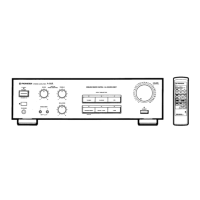
Do you have a question about the Pioneer A-351R and is the answer not in the manual?
| power requirements | 240 Volts, 50/60 Hz |
|---|---|
| power consumption | 325 W |
| continuous power output (20 Hz to 20 kHz) | 30 W + 30 W |
|---|---|
| DIN continuous power output (1 kHz) | 45 W + 45 W |
| dynamic power output | 60 W |
| phono input sensitivity/impedance | 2.5 mV/50 kQ |
|---|---|
| cd, tuner, line, tape 1/dat, tape 2/adpt input sensitivity/impedance | 150 mV/50 kQ |
| tape 1/dat, tape 2/adpt output level/impedance | 150 mV/1 kQ |
| dimensions | 420 (W) x 336 (D) x 125 (H) mm |
|---|---|
| weight | 5.6 kg |
Convenience combined with no-compromise performance for Pioneer audio equipment with SR mark.
45W + 45W at 4 ohms, DIN, with low-impedance driving capability for better digital sound.
The "DIRECT" button bypasses tone and balance controls for highest purity results.
Automatically boosts lows and highs when volume is lowered to compensate for bass and treble.
Features 6 input options and connections for two pairs of speaker systems.
Install in a well-ventilated, dry location away from high temperatures or direct sun.
Handle plug carefully, avoid wet hands, do not pinch or knot the cord.
Wipe with a soft cloth, avoid chemicals, thinners, or sprays.
Controls the amplifier's power state; indicator shows standby mode.
Adjust tone/balance based on volume; balance affects left/right sound.
Selects playback source: PHONO, TUNER, CD, LINE, TAPE 1/DAT, TAPE 2/ADPT.
Use to adjust the playback volume level.
Receives remote signals; headphone jack for private listening.
Selects speaker systems A or B for playback.
Bypasses tone controls for pure sound reproduction.
PHONO, TUNER, CD, LINE, TAPE 1/DAT, TAPE 2/ADPT terminals.
SPEAKERS A/B terminals, CONTROL OUT jack.
Turntable ground terminal (GND) and Power cord connection.
Connects turntables, tuners, CD players, VCRs, and tape decks.
Connects speaker systems B (R/L) and A (L/R).
Connects the unit to an AC wall socket or audio timer.
Steps for stripping wire and securing speaker cords into terminals.
How to connect white (L) and red (R) plugs securely.
Connecting Pioneer components for system operation using control cords.
Set power, speaker selection, and DIRECT button before use.
Select input, adjust volume, tone, and balance controls.
Procedures for recording tapes and copying between decks.
Using an audio timer for unattended recording operations.
How to insert AAA batteries correctly into the remote compartment.
Details the effective distance and angle for remote control operation.
Guidelines for correct polarity, mixing batteries, and battery types.
Buttons for operating cassette decks, tape operations, and selectors.
Buttons for CD power, tuner power, and selecting input sources.
Buttons for adjusting volume and tuning stations.
Solutions for no power, no sound, or one-speaker sound issues.
Troubleshooting tape copying, recording, and remote control malfunctions.
Continuous power, THD, frequency response, input sensitivity, S/N ratio.
Power requirements, consumption, unit dimensions, and included accessories.
